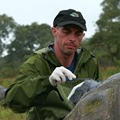Feature Papers for Land, Biodiversity, and Human Wellbeing Section
A special issue of Land (ISSN 2073-445X). This special issue belongs to the section "Land, Biodiversity, and Human Wellbeing".
Deadline for manuscript submissions: closed (5 July 2023) | Viewed by 10961
Special Issue Editors
Interests: tropical forest change; wildfire management; rural development and forest conservation; land use; forest transitions; payment for environmental services; REDD+; GIS/remote sensing
Special Issues, Collections and Topics in MDPI journals
Interests: food webs; biodiversity; population, community and ecosystem ecology; fisheries; ecosystem-based management; biocomplexity; biological oceanography; climate change; philosophy
Special Issues, Collections and Topics in MDPI journals
Special Issue Information
Dear Colleagues,
Land-change dynamics affect biodiversity and, in turn, human wellbeing at both societal and individual scales. Land-change dynamics are typically driven by short-term economic imperatives that rarely acknowledge their implications for biodiversity and/or human wellbeing. These implications are often somewhat removed from actual land-change dynamics or are otherwise unquantified. Human wellbeing, broadly defined, remains tenuously understood in relation to ongoing biodiversity losses driven by land change.
This Special Issue welcomes submissions that highlight the nexus of land change, biodiversity, and wellbeing with respect to its trends, compromises, and controversies. All article types are welcome, from full empirical studies to short research notes to commentaries and reviews.
Dr. Sean Sloan
Dr. Andrea Belgrano
Dr. Stephen Blake
Guest Editors
Manuscript Submission Information
Manuscripts should be submitted online at www.mdpi.com by registering and logging in to this website. Once you are registered, click here to go to the submission form. Manuscripts can be submitted until the deadline. All submissions that pass pre-check are peer-reviewed. Accepted papers will be published continuously in the journal (as soon as accepted) and will be listed together on the special issue website. Research articles, review articles as well as short communications are invited. For planned papers, a title and short abstract (about 100 words) can be sent to the Editorial Office for announcement on this website.
Submitted manuscripts should not have been published previously, nor be under consideration for publication elsewhere (except conference proceedings papers). All manuscripts are thoroughly refereed through a single-blind peer-review process. A guide for authors and other relevant information for submission of manuscripts is available on the Instructions for Authors page. Land is an international peer-reviewed open access monthly journal published by MDPI.
Please visit the Instructions for Authors page before submitting a manuscript. The Article Processing Charge (APC) for publication in this open access journal is 2600 CHF (Swiss Francs). Submitted papers should be well formatted and use good English. Authors may use MDPI's English editing service prior to publication or during author revisions.







